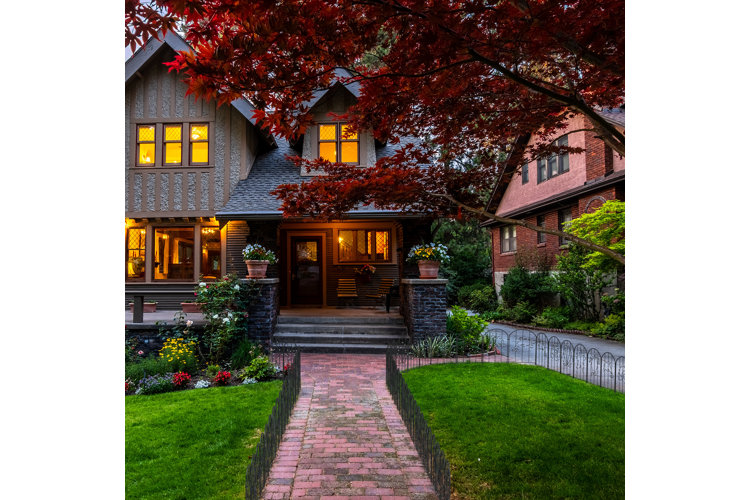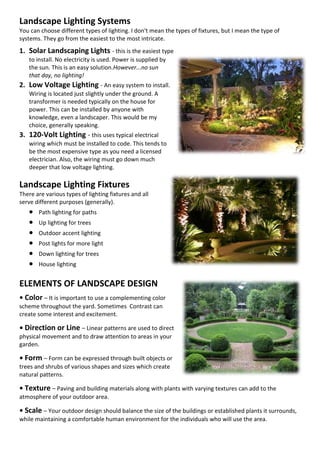The Greatest Guide To Hilton Head Landscapes
The Greatest Guide To Hilton Head Landscapes
Blog Article
Get This Report about Hilton Head Landscapes
Table of ContentsEverything about Hilton Head LandscapesAn Unbiased View of Hilton Head LandscapesGetting My Hilton Head Landscapes To WorkThe 2-Minute Rule for Hilton Head LandscapesA Biased View of Hilton Head LandscapesA Biased View of Hilton Head LandscapesHow Hilton Head Landscapes can Save You Time, Stress, and Money.
Line develops all types and patterns and can be used in a selection of methods the landscape. Line in the landscape is created by the side in between 2 materials, the outline or shape of a form, or a long direct attribute. Lines are a powerful tool for the developer because they can be utilized to create an infinite range of forms and types, and they regulate motion of the eye and the body.

Lines in the landscape. The properties of lines identify just how people respond to the landscape, both mentally and literally.
All about Hilton Head Landscapes
Straight lines are frequently located in hardscape sides and product. Bent lines develop a casual, all-natural, relaxed character that is associated much more with nature and asymmetrical balance. Curved lines move the eye at a slower pace and include enigma to the room by developing surprise sights. Upright lines move the eye up, making an area feel larger.
Upright lines in the landscape consist of tall, slim plant product, such as trees, or tall structures, such as an arbor or a bird house on a post. Straight lines move the eye along the ground plane and can make a room feel larger. Reduced lines are a lot more restrained and produce a feeling of remainder or repose.
Examine This Report about Hilton Head Landscapes
Reduced lines are produced by reduced garden wall surfaces, walkways, and brief hedges. Lines are utilized to attract types on a strategy. In plan sight, they define plant beds and hardscape areas. Lines are additionally produced by the upright forms of constructed features and plant product. There are 3 primary line kinds that develop form in the landscape: bedlines, hardscape lines, and plant lines.
Bedlines connect plant material to your home and hardscape since the eye complies with the line, relocating the gaze through the landscape. Hardscape lines are produced by the side of the hardscape, which marks the built structure. Line can likewise be developed by lengthy and slim materials, such as a fence or wall surface.
Hilton Head Landscapes - Questions
Type is discovered in both hardscape and plants, and it is commonly the leading aesthetic aspect that spatially arranges the landscape and commonly figures out the style of the garden. The form of frameworks, plant beds, and yard accessories likewise identifies the general form motif of the yard. Official, geometric forms include circles, squares, and polygons.
Plants create kind in the yard with their details or silhouettes, yet form can also be defined by a gap or unfavorable area between plants - bluffton landscaping (https://hub.docker.com/u/h1tnhdlndscps). Circles can be cycles, or they can be split into fifty percent circles or circle sections and combined with lines to develop arcs and tangents
Hilton Head Landscapes Fundamentals Explained
Circles are a solid design type since the eye is constantly drawn to the center, which can be made use of to emphasize a focal point or attach other types. Round kinds in hardscape and lawn panels.
The square kind can additionally be segmented and previously owned consistently to produce a grid pattern. Unlike circles, squares are more powerful on the brink, which can be aligned or overlapped to develop special patterns and even more intricate forms. Polygons are many-sided types with straight sides. Triangulars, for instance, are three-sided polygons.
Meandering lines usually imitate the natural program of rivers or streams and can be explained as smooth lines with deeply rounded undulations. Meandering lines (Figure 3) work well for pathways, plant bedlines, and dry stream beds. Meandering lines can add interest and mystery to a garden by leading audiences around corners to discover new sights and rooms.
More About Hilton Head Landscapes

Usual plant types are well established and standard, as type is the most consistent and recognizable feature of plants. Kind can additionally be produced through the massing of plants, go to this web-site where the general mass produces a different kind than a specific plant.
An extremely different form should be used with careone or more job well as a centerpiece, but a lot of develop turmoil. Natural plant kinds, instead of over-trimmed forms, must develop the bulk of the composition. The relevance of total form is essentially reliant on the seeing perspectivethe form of a tree can show up quite different to an individual standing under the cover versus checking out the tree from a range in an open area.
Rumored Buzz on Hilton Head Landscapes
Plant types additionally produce and define deep space or open areas between the plants, creating either convex or scooped forms in deep spaces. High-arching tree branches generally develop a concave open area under the branches, and a round cover with low branches loads the area to create a convex kind in the open room under the tree.

Report this page